Is today’s Athens a testament to its legendary ancient past? Or is Athens better described as an innovative and ultra-modern city? Check out these 13 astounding facts about Athens to learn more about Greece’s capital city!
This article isn’t meant to replace a guided visit – quite the opposite! Reading up on an attraction will make a guided tour more memorable and interesting! You will impress your travel partners and engage more with the guide. Check out our guided tours of Athens!
13 Amazing Aspects of Athens
At first glance (at least once you stop looking up at the Acropolis), Athens appears a very modern city. But as scholar Robin Waterfield explains, this first impression is deceiving. In fact, the urban core of Athens is full of reminders of earlier historical periods.
For instance, we’ll see ancient ruins next to metro platforms and a historic church at the entrance to one of the city’s hotels. Indeed, as historian Michael Llewellyn-Smith suggests, Athens is an eclectic mix of diverse styles and historical eras.
In other words, think of Athens like the layers of an onion or a 7-layer dip (with more layers). These 13 astounding facts get us to the heart of the city’s rich history. Sadly, there’s no food at the end of the page. Let’s begin!
13. The Entrance to the Acropolis Museum Contains Ancient Ruins
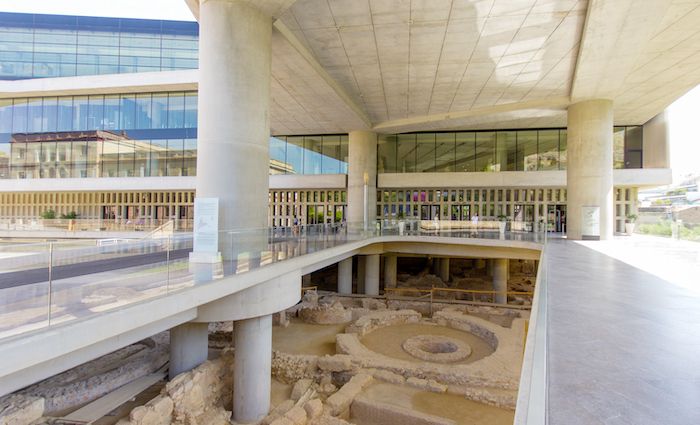
Modern Museum | Past & Present | Ancient Neighborhood
The Acropolis Museum, located adjacent to the famous Acropolis dates to 2007. Initially, organizers slated the museum’s opening to coincide with the 2004 Olympic Games in Athens. However, as archaeologist Eugene Vanderpool explains, archaeological discoveries disrupted construction. Yet, because of the delay Vanderpool continues, the architects became inspired to redesign the museum to incorporate the findings.
Thus, even this modern museum rests upon an excavated ancient Athenian neighborhood. In fact, as scholar Chelsey Parrott-Sheffer explains, the ruins visible at the museum’s entrance encompass multiple historical periods. While most of the remains date to the 7th-9th centuries AD, there are traces of earlier times.
Fortunately, the museum’s collection reflects many highlights of those earlier times. Specifically, our focus is on the so-called Golden Age of Athens in the 5th century BC. In that era, historian Paul Cartledge reminds us that Athens gained many of the monuments and characteristics that continue to fascinate us in the 21st century. Without a doubt, the most famous of these are the temples located on top of the Acropolis.
12. The Many Uses of the Acropolis
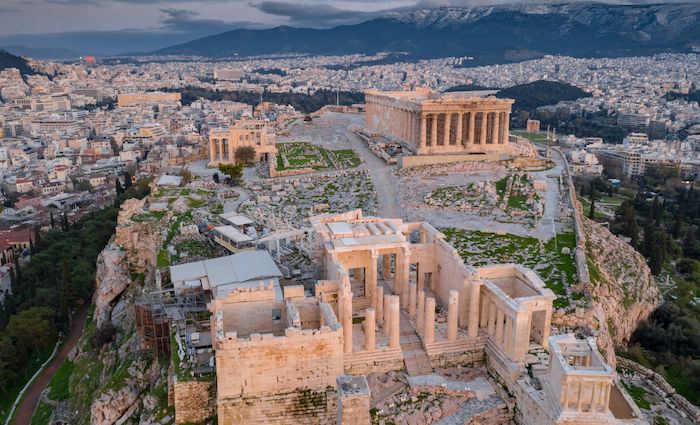
Spiritual Heart | Athenian Golden Age | Fortress
Indeed, there’s no better space in Athens to see evidence of the city’s so-called golden age than the legendary Acropolis. The hill as historian Paul Cartledge tells us is part fortress part ancient spiritual center with an impressive temple complex.
The Parthenon (temple dedicated to the goddess Athena) is a great example of this Athenian revival in the Golden Age of Athens. Built between 447-432 BCE, it awed any visitor. However, the Parthenon was more than just an imposing shrine to Athena. For example, historian Paul Cartledge tells us it housed the city’s extensive gold reserves.
However, as archaeologists Christopher Mee and Anthony Spawforth tell us, the Acropolis experienced many different uses over the centuries. In fact, the Acropolis functioned as a fortress both in antiquity and during the Greek Revolution in the 19th century.
Furthermore, as scholar Richard Stoneman explains, the Acropolis housed temples and later churches and mosques. Finally, as historian Michael Llewellyn-Smith points out, the Acropolis became primarily an archaeological site in the 19th century.
Don’t miss our Top 11 Things to See at the Acropolis!
11. Archaeology in the Metro Stations
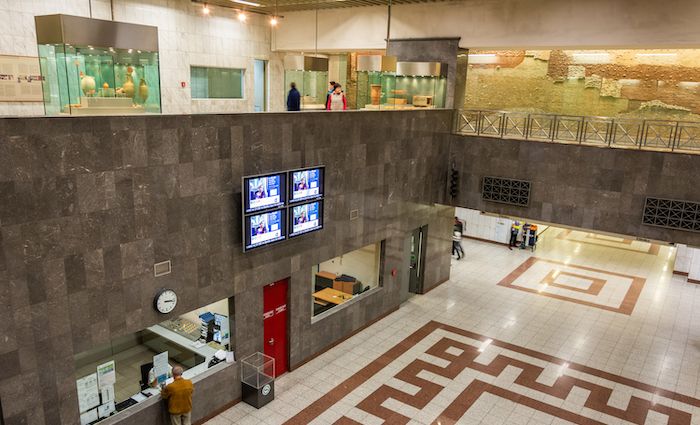
Museum-Quality Exhibits | Historic Transport | History lessons on the train platforms
There’s so much history to see in Athens that even some metro stations are museum-like. In fact, several metro stations in central Athens exhibit evidence of archaeological finds. Scholar Richard Stoneman tells us much of this was discovered during metro extensions in the 1990s and early 2000s.
So, what can you see in the metro stations? For starters, historian Michael Llewellyn-Smith tells us about the remains of an ancient, vaulted riverbed visible at Monastiraki station. In fact, I always enjoy waiting near the entrance to the Line 1 platform towards Kifisia because you must pass the archaeological excavation. You can also see evidence of ancient aqueducts and other artifacts at stations like Syntagma and Evangelismos. Thus, here we have great examples of the historical layers that make up modern Athens.
Moreover, to ride on Line 1 of the Athens Metro (Piraeus-Kifisia) is a journey through transportation history. In fact, as scholar Richard Stoneman tells us, this metro line dates to 1869! For comparison, historian Oliver Green reminds us that London’s famous Tube originally dates to 1863. Back in the late 19th century, Stoneman continues, this was a steam-powered line developed by British engineers. Moreover, the line was electrified by the early 20th century.
10. Visit the First Modern Olympic Stadium
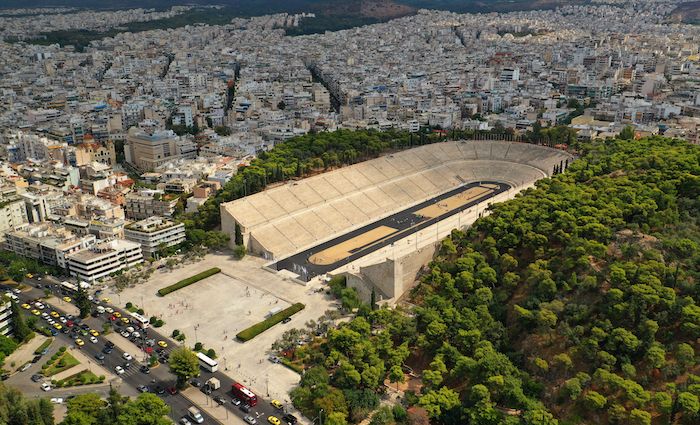
Modern Olympics | Ancient Stadium | A Lot of Marble
If you’re a fan of the Olympic Games, you probably know the strong connections between the Olympiad and Greece. In fact, Greece is not only the home of the original ancient version of the games but also hosted the first modern iteration in 1896 AD.
Known as the Panathenaic Stadium, or Kallimarmaro (“beautiful marble”), because as you might guess there is a lot of marble. Moreover, this venue boasts a fascinating history. For instance, scholars believe a stadium has stood on the site as far back as the late 4th century BC.
Moreover, according to scholar Richard Stoneman, wealthy Roman-era Athenian Herodes Atticus funded its reconstruction in marble during the 140s AD. By the 4th century AD though the stadium became neglected.
Finally, historian Roderick Beaton explains architect Anastasios Metaxas then renovated the stadium and had it set for the 1896 Olympics. Thus, only in Greece can you pretend to race for the gold on the grounds of both the first modern and ancient Olympic stadiums.
9. Visit the World’s Largest Collection of Ancient Greek Antiquities
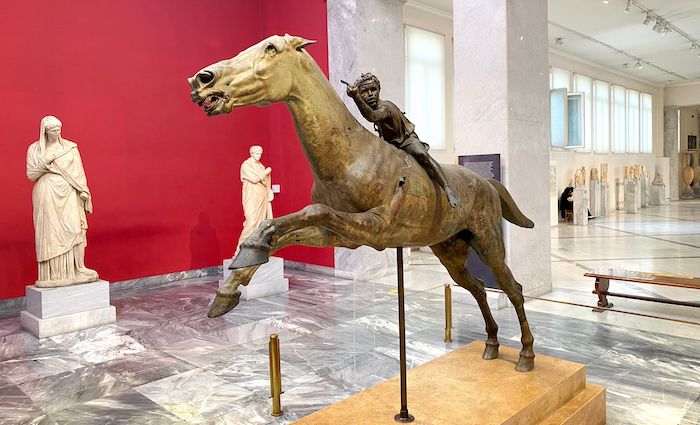
National Archaeological Museum | Expansive | National Treasures
A visit will certainly not disappoint. The National Archaeological Museum boasts a vast collection of Greek antiquities. Moreover, there are treasures from ancient Egypt and Cyprus. Chronologically, the museum covers the immense ground. In fact, as archaeologist Elisavet Stasinopoulou explains, the collection spans the years from 7000 BC to 500 AD.
Highlights as archaeologist Despina Ignatiadou tells us, include a bronze statue of Zeus or Poseidon, Minoan frescoes from Thira (Santorini), and the legendary gold-plated so-called “Mask of Agamemnon.”
The museum itself is massive and there’s no chance you’ll see everything in one quick trip. If you’re planning a visit, check out our article about the National Archaeological Museum’s must-see highlights!
8. Famous Hills
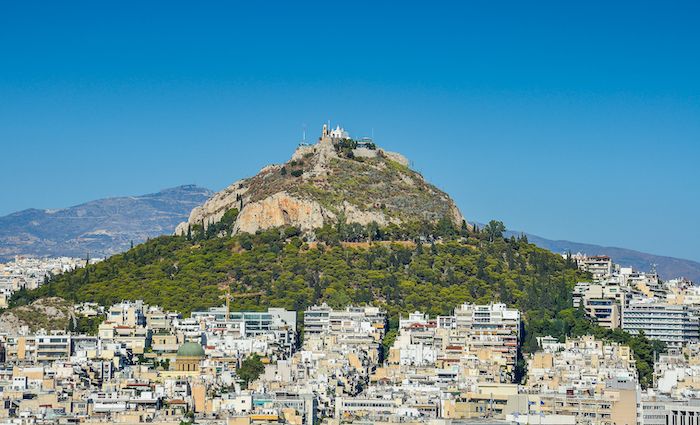
Athenian Democracy | Wolves? | City Views
Move over Rome and Boston because Athens also claims some famous hills. We’ll focus here on two examples. The first of these is the Hill of Pynx. As scholar Thomas N. Mitchell tells us, this is where we would have encountered famous ancient Athenians like Pericles practicing democratic traditions. In fact, Mitchell tells us this is where the city’s Democratic Assembly once met.
Our second hill offers some of the best views of Athens. Situated in the city center, Lykavittos (Hill of Wolves) is like an oasis of nature in the heart of Athens. The name as Richard Stoneman explains dates to antiquity when it is said the hill’s inhabitants were primarily wolves. Even still, there is considerable green space and tree coverage amid a sea of concrete.
Today you can follow a trail up the hill or take a ride on the funicular railway to the summit. Once there, you’ll find stunning city views and the tiny chapel of St. George.
7. Roman Athens
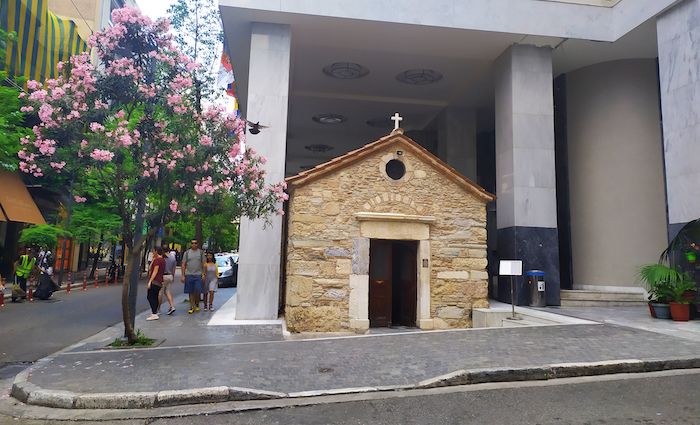
Emperor Hadrian’s Gifts | Urban Renewal | Religious Changes
Athens faded in status and glory by the time Imperial Rome conquered Greece by the 160s BC. However, the city benefited from the largesse of the important Roman emperor Hadrian (reigned AD 117-138). In fact, archaeologists Christopher Mee and Anthony Spawforth say that Emperor Hadrian certainly developed a soft spot for Athens and all things Greek culture. For instance, Hadrian even earned the nickname “Graeculus” (Greekling). What did Hadrian do to earn this moniker?
For example, historian Ian Worthington explains Hadrian built a library and many other public buildings and monuments. Today, you can still visit several sites including the ruins of Hadrian’s Library and Hadrian’s Arch in central Athens.
Athens next experienced a revival under Byzantine or Eastern Roman imperial rule. Moreover, many changes occurred when Byzantium governed Athens. For example, historian Paul Cartledge tells us that Emperor Justinian dealt a fatal blow to pre-Christian traditions in Greece. In fact, Cartledge explains in 529 AD closed all Greek schools of philosophical (read pre-Christian) teachings including the famous Academy of Athens.
Moreover, today’s city boasts several examples of Byzantine Orthodox Christian churches. Although built after Byzantine rule in the 16th century, the church of Ayia Dynami (Holy Power) is one of my favorite monuments in Athens. How many times can you say you’ve seen a historic church built within the property of a modern luxury hotel? That’s right, today the church is located adjacent to the entrance of the Electra Metropolis Hotel.
6. Ancient Versions of Modern Favorites
Ancient Shopping | Ancient Awards | Architectural Gems
As we’ve already seen, there are so many examples of ancient connections to modern elements of Athens. Here we’ll encounter two of my favorite instances of ancient versions of familiar features of our society. Our first example involves shopping.
Archaeologist Homer A. Thompson tells us that the Stoa of Attalos II was originally built in the 150s BC. Moreover, scholar Richard Stoneman explains the structure in the Ancient Agora is named after its donor, King Attalos II of Pergamon. Attalos hoped Athenians would visit this shopping arcade and admire his kingdom’s wealth and status. In the 1950s AD, Homer A. Thompson explains that the American School of Classical Studies rebuilt the structure to house archaeological finds from the Ancient Agora.
Our second example turns to the awards season for show business. We know every year there is much talk about awards ceremonies for the best in film, music, theater, tv etc. Well, that tradition goes back to Ancient Athens. In fact, you’ll find a surviving example of one such ancient award only a short walk from the Acropolis.
The Monument of Lysicrates dates to 334 BC. As archaeologists Christopher Mee and Anthony Spawforth point out, this is a choragic monument related to drama competitions held at the theatres beneath the Acropolis. It commemorates Lysicrates’ sponsorship of a chorus that won in these competitions. So, you can think of it as a kind of a permanent award or trophy situated in the middle of Athens. According to Mee and Spawforth, it is the only surviving monument of its kind and the first to use Corinthian capitals externally.
5. A Greek Island in Athens

Peaceful | Selfie Spot | Traditional Homes
Well… sort of. Perhaps it is more accurate to say visiting the neighborhood of Anafiotika is the closest you’ll get to a Greek island feel in the big city. The reason for this island vibe in the middle of Athens surrounds the influx of stonemasons from the island of Anafi.
As scholar Richard Stoneman explains, officials in the newly independent Greek state in the 1830s and 1840s believed their capital city Athens needed a makeover. As a result, historian Richard Clogg tells us that many architects, engineers, artisans, and laborers came from across Europe and Greece to take part in a construction boom.
This mid-19th century construction craze brings us to our islander stonemasons and this Athenian neighborhood. Richard Stoneman tells us that the stonemasons from Anafi were brought to Athens to build the royal palace (today’s Greek Parliament). In need of a place to live while they worked in Athens, the expert craftsmen built a slice of their island home in the heart of Athens.
As a result, you’ll find this tiny quaint maze of whitewashed homes to be a perfect primer for a Greek island odyssey. Alternatively, Anafiotika is a welcome break from the hustle and bustle of modern Athens and an ideal selfie spot on your way to the Acropolis.
4. Socrates’ Prison
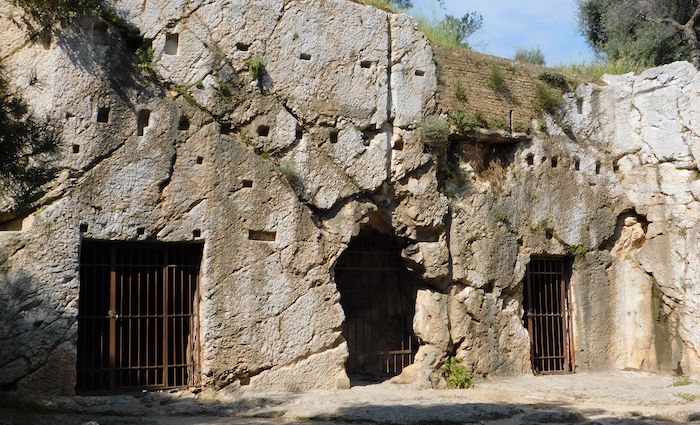
Dramatic | Imposing | Famous Philosopher’s Death
Southwest of the Acropolis we find Filopappou Hill. Scholar Richard Stoneman reminds us that it is also known as the Hill of the Muses. Moreover, Plutarch tells us that the legendary Theseus battled the Amazons on this hill. The hill’s summit is crowned by the Monument of Filopappos. Historian Ian Worthington explains that this is a Roman-era monument built between 114-116 AD.
However, Filoppapou Hill is arguably most famous for housing the so-called Socrates’ Prison. It is said that it was here that Athenians held the legendary philosopher Socrates. What we know according to historian Paul Cartledge is that Socrates faced trial by a democratic People’s Court in 399 BC. So, what did Socrates allegedly do to warrant this trial?
Historian Paul Cartledge tells us Socrates faced two charges by this Athenian court. The first of these involved his refusal to honor the gods favored by Athens (and inventing deities on top of this). Finally, Socrates was accused of corrupting the young men of Athens (meaning that he taught them anti-democratic tendencies).
In the end, Cartledge explains the majority found Socrates guilty and sentenced him to death. According to Plato, Socrates died a “philosopher’s death” by self-administered hemlock. Furthermore, Paul Cartledge says that many believe the trial reflects a terminal decline of Athenian democracy.
3. Syntagma Square
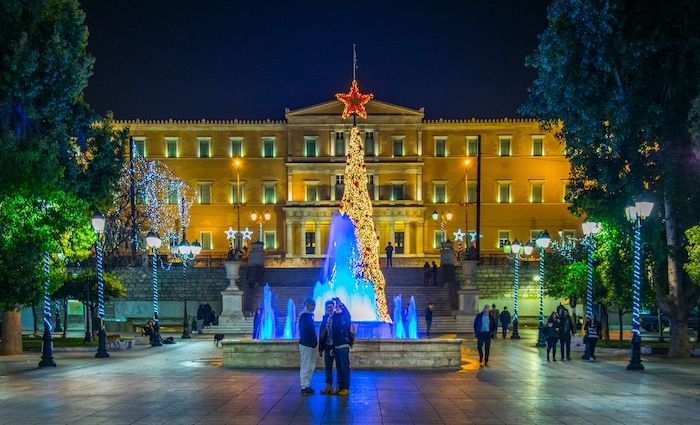
Political Center | Social Hub | Pulse of the Nation
The Acropolis may be the most recognizable place in Athens. However, the heart of modern Athens (and arguably of Greece) is Syntagma (Constitution) Square. The central square is named after the country’s 1843 Constitution. Historian Kostas Kostis explains that the country’s king Otto I granted the constitution after a forceful protest by army officers and leading officials.
Since the mid-1930s, Syntagma Square has hosted the country’s parliament. However, the building where parliament now meets formerly housed a diverse crowd. In fact, as historian Richard Clogg tells us, it originally housed the Greek royal family and later refugees from the Greek-Turkish Population Exchange in 1923.
Little did King Otto know that Syntagma Square would emerge as the central point of any major protest (or celebration) in Athens. Although dominated by the country’s Parliament building, the square also houses several historic luxury hotels and businesses. Moreover, there are multiple cafes where you can really gauge the national attitude on any topic (especially the play of the most famous soccer clubs).
2. Changing of the Guard/Parliament/Tomb of the Unknown Soldier

Pomp | Tradition | Duty
Indeed, the highlight of any trip to Syntagma Square is a glimpse of the famous Evzones (Presidential Guard). These elite Greek soldiers stand guard beneath the Parliament building at the Tomb of the Unknown Soldier.
On Sundays and national holidays, you’ll see the guards dressed in the traditional white pleated kilts and distinct pom-pom shoes. As scholar Richard Stoneman explains, the uniform is full of national symbolism. For instance, Stoneman says the uniform relates to the clothing worn by Greek revolutionary fighters in the early 19th century. While the changing of the guard occurs hourly daily, my tip would be to check out the 11 A.M. Sunday ceremony when an entire platoon marches.
Moreover, uniforms vary slightly depending on the time of year. In other words, you can witness this ceremony on many occasions and notice a new feature. While the uniforms are certainly eye-catching, you’ll probably be most impressed by the athleticism, precision, and synchronization involved in each movement during any changing of the guard ceremony.
1. The Parthenon Remained Largely Intact until the 17th Century
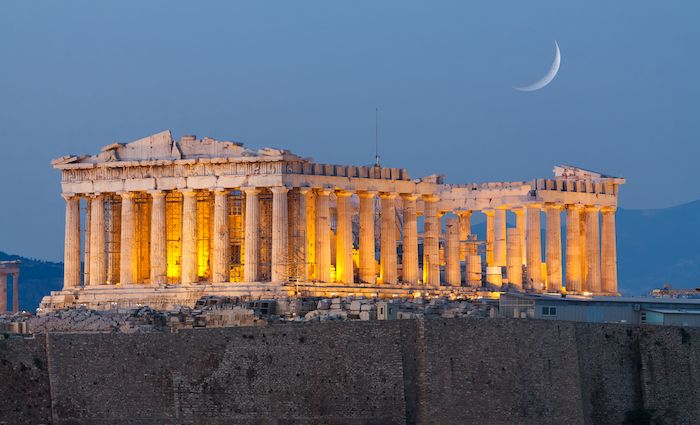
Wear & Tear? | Conflict & Controversy | Timeless
Generations of visitors are used to seeing quite a bit of scaffolding and ancient rubble in the Parthenon’s vicinity. However, in historical terms, the Parthenon’s present appearance is of a relatively recent nature. In fact, as scholar David Brewer tells us, the Parthenon largely took on these features in the late 17th century. As Richard Stoneman reminds us, this is remarkable considering the Parthenon dates to the 440s BC!
The primary culprit is a conflict between the Ottoman Empire and Venice in the 1680s. After the siege, the site suffered pillaging and the controversial removal of antiquities by British diplomat and aristocrat Lord Elgin in the 19th century.
Despite that damage and the subsequent controversy, the Parthenon remains one of the world’s great treasures. Indeed, the Parthenon and the other attractions on the Acropolis will continue to fascinate visitors just as they have since ancient times.
Want more Athens? Check out a deeper dive into the history of Athens


